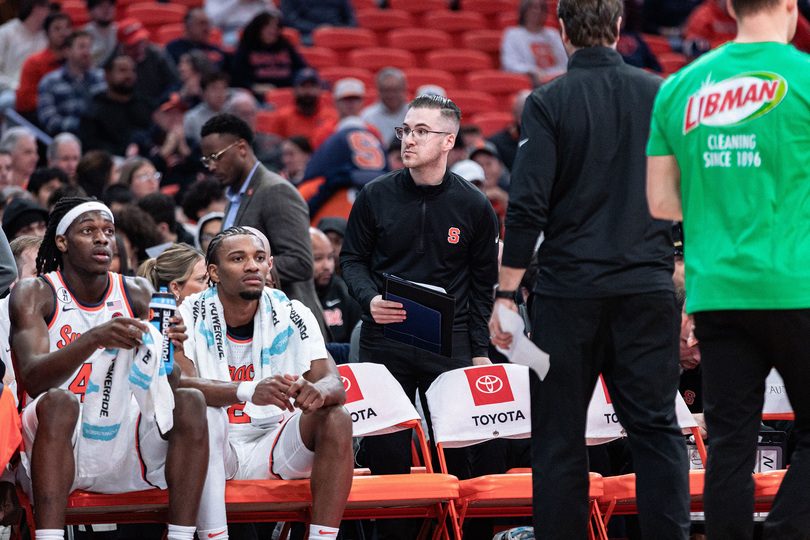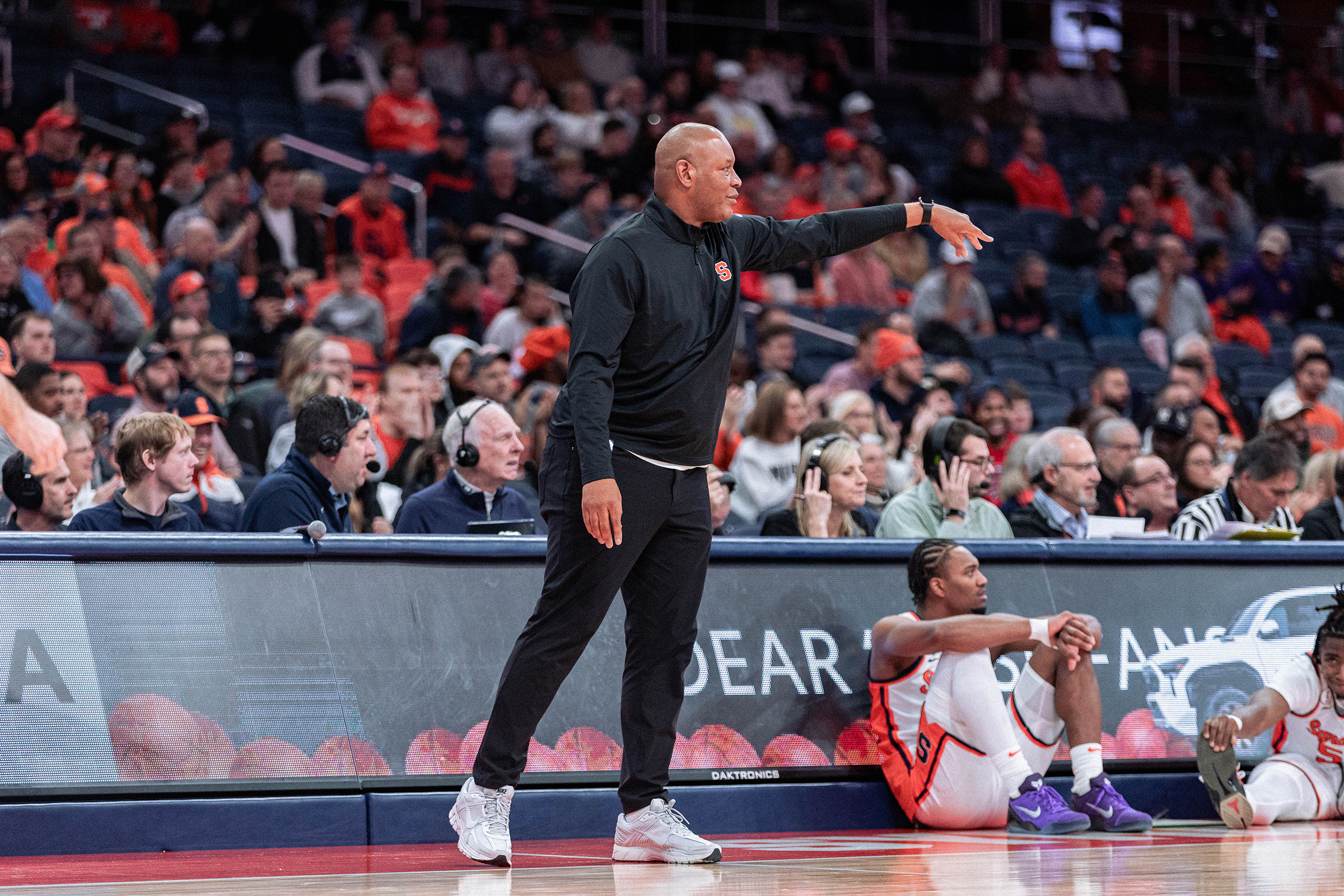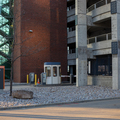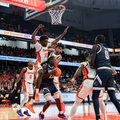Syracuse’s rebuild blueprint — and quest to rejoin college basketball elite

SU men’s basketball rebuilt its roster this offseason. Our beat writer dives into the Orange’s quest to rejoin college basketball’s elite. Joe Zhao | Senior Staff Photographer
Get the latest Syracuse news delivered right to your inbox. Subscribe to our sports newsletter here.
After sitting at the podium dejected, Adrian Autry let out a brief chuckle. Throughout his press conference, the head coach somberly answered questions after Syracuse’s worst campaign since 1968-69 officially concluded with an Atlantic Coast Conference Tournament loss to SMU.
Then he was asked about the growth of the players who would be returning the following year. Autry laughed before taking six seconds to find an answer.
“The way that everything is right now, you don’t know who is coming back. That’s an honest answer,” he said.
Among the seven scholarship players who had eligibility, J.J. Starling and Donnie Freeman were the only two who returned for the 2025-26 season. The Orange then overhauled their roster by netting a program-high six transfers and a premier freshmen class, setting the stage for them to compete with college basketball’s upper echelon in the Players Era Festival next week.
Led by Autry and general manager Alex Kline, Syracuse’s offseason rebuild has led to early success during a pivotal year for a program stuck in its longest NCAA Tournament drought in over five decades. Off to a 4-0 start, a win over Houston or Kansas in Las Vegas would put SU back on college basketball’s map for the first time since the 2021 NCAA Tournament.
So how did the Orange get here? It started with honest conversations.
Among Starling and Freeman’s 15 teammates on last season’s roster, eight were in their final year of eligibility. Five of the seven remaining players — Chris Bell, Elijah Moore, Kyle Cuffe Jr., Petar Majstorovic and Chance Westry — entered the transfer portal. Meanwhile, the other two were walk-ons: Noah Lobdell is back with the program, but Chris Gatty is now just a student at SU.
Following the season, Gatty said every player had an exit meeting. Autry explained there was “kind of an understanding” in his conversations with the players who transferred.
“You just have to have honest man-to-man conversations,” Autry told The Daily Orange during SU’s Media Day.
Kline noted that Autry led those conversations, keeping it “very black and white.”
“I think ‘cut’ may be a little harsh,” Kline told The D.O. during Media Day, “It was more of, ‘Hey, in a way, your contract is up for the year, like in any other business, we appreciate what you did. We’re gonna move forward.’”
The general manager declined to say which players Autry had those conversations with. He added that they tried to end all the relationships on positive terms, because they all contributed to the program and could still influence recruiting.
Requests for The D.O. to speak with Bell (California), Moore (Utah), Cuffe (Mercer), Majstorovic (Long Beach State) and Westry (University of Alabama at Birmingham) were all denied or received no response.

Ilyan Sarech | Design Editor
Though with Starling and Freeman — SU’s leading scorers from last year, who only played seven games together due to injuries — back and its incoming freshmen class, the program had a base. Starling said he felt like a “recruiting coach,” as the Orange’s staff consulted him and Freeman on transfer portal options. They spoke directly with portal targets and studied how possible additions would fit with their playing styles.
Long before Starling and Freeman’s involvement, Syracuse’s portal evaluation began in 2024, when Kline was hired and former student manager Eugene Tulyagijja was retained as a data analyst. Though SU added Kline before the 2024-25 season, that came after its roster was already built.
In his first season with the program, Kline did behind-the-scenes research, made scouting trips and sat in the second row of SU’s bench during games. Throughout the season, he said he watched a lot of basketball and made lists of who would be great, good and okay fits in the portal.
Beginning when Kline was hired, though, he and Tulyagijja — who recently left SU to join the New York Knicks’ coaching staff — built an algorithm to help identify and quantify talent. Tulyagijja acknowledged that they used the algorithm last season to track potential portal targets and said it was heavily utilized.
“I saw from afar (in 2024), but this year, I feel like we were process-oriented,” Tulyagijja told The D.O. in October. “We knew what we wanted, and we went out and got what we wanted.”
The algorithm was built around Kline’s NBA scouting experience and Tulyagijja’s prior work with the Cleveland Cavaliers’ analytics department. It helped the Orange identify freshmen Luke Fennell and Aaron Womack on the high school circuit, but their first full run was over the offseason.
One key component of the algorithm that mirrored the NBA was how Syracuse valued players. Instead of relying on the algorithm to spit out a number that a player should cost, Tulyagijja said they instead viewed it as what portion of their budget they’d be willing to spend on that player.
Autry and Kline both declined to say how much the Orange spent. However, Kline said they spent every dollar they were given.
Beyond the monetary aspect, a major part of the algorithm, Tulyagijja said, was fit percentage. Though Tulyagijja didn’t describe its calculation, he explained that the Orange looked to add players who’d best fit alongside Starling and Freeman. He referenced Win Shares as another metric that SU looked at.
Before the portal opened, Tulyagijja said the Orange knew they wanted a big-time point guard, an athletic center and a shooter to pair with Starling and Freeman. Three days after the portal officially opened, William Kyle III committed, checking the second box.
The UCLA transfer told The D.O. in March that it was a quick process because he fell in love with Syracuse, adding he trusted SU’s vision and what the coaches were doing. Thus far, the athletic center has been a match made in heaven.

Syracuse head coach Adrian Autry paces the sidelines at the JMA Wireless Dome during SU’s win over Monmouth. Autry’s revamped roster includes six transfers and five freshmen. Joe Zhao | Senior Staff Photographer
During his recruiting process, Kyle said the coaching staff told him that Naithan George — who led the ACC in assists as a sophomore at Georgia Tech — was on its radar. When George entered the portal, Syracuse assistant Brenden Straughn said he was surprised, while Kline said the Orange quickly pounced with a “full court press.” Autry added they were “all in.”
Syracuse’s coaching staff — along with Starling and Freeman — called, FaceTimed and talked over Zoom with George. The point guard said SU calling him every day and the coaches checking in with his parents “meant the world” to him. Backed by financial resources to the point where Kline said they never considered dropping out, George committed on April 4.
A similar approach helped SU land Nate Kingz, who fit the bill of the shooter after making 44.6% of his 3-pointers at Oregon State last season. Once Kingz entered the portal, he said it was a quick process because the Orange instantly reached out for a potential visit.
Kingz said “everybody” with the program hit him up, acknowledging it was also a full-court press. Two days before Syracuse landed George, Kingz committed.
With Kyle, George and Kingz’s commitments, SU accomplished its three main portal goals.
Meanwhile, Akir Souare (Georgia Tech), Tyler Betsey (Cincinnati) and Bryce Zephir (Montana State) rounded out the Orange’s six-player class. As Syracuse has surged to a 4-0 start, they’ve all become an instrumental part of its “juicing station.”
Instead of pairing Starling and Freeman with primarily mid-major players transferring up to the power level, like they did last year, the Orange instead found legitimate talent. By also adding highly-touted freshmen Sadiq White Jr. and Kiyan Anthony, SU built a team capable of restoring the “Orange Standard.”
The early results have been strong. Syracuse has seen its KenPom ranking rise to No. 53, while EvanMiya has it at No. 40.
Unlike last year, when they failed to win a game against a Quad 1 opponent, the Orange now have the talent to compete with the likes of Houston and Kansas in college basketball’s upper echelon. The real vindication — for Autry, Kline, the algorithm and the program — would start with a win in Las Vegas.
Unlike eight months ago, when Autry spoke to reporters following one of the worst seasons in program history, he’s not taking a gamble on unknowns and how they’d fit together. Backed by uncomfortable conversations, analytics and a detailed process, he has a roster built to compete with anyone.
Senior Staff Writer Aiden Stepansky contributed reporting to this story.





